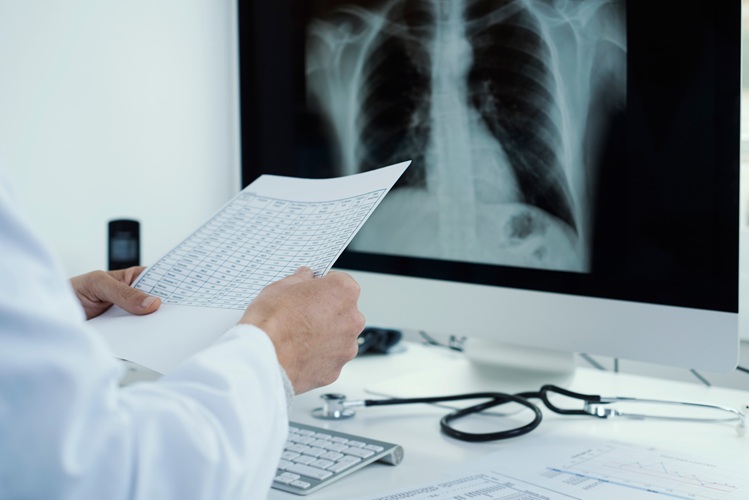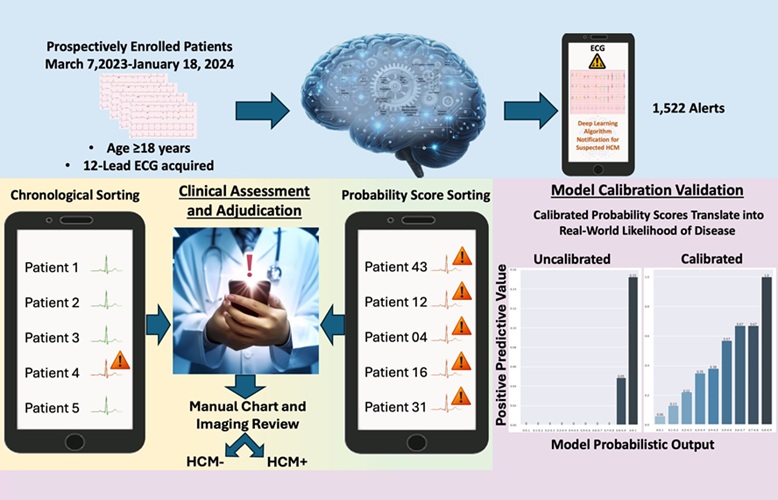New Way to Determine Need for Aneurysm Surgery
|
By HospiMedica staff writers Posted on 24 Apr 2003 |
A new noninvasive method for predicting abdominal aortic aneurysm (AAA) rupture risk and the need for surgery has been shown to be better than measuring the aneurysm's diameter, used in the past for this purpose. The method was described in the April 2003 issue of the Journal of Vascular Surgery.
More than 100 patients who had computed tomography (CT) scans during the course of routine care had AAA wall-stress analysis. The CT scan is processed through a series of computer programs, including an engineering process called finite element analysis. This breaks the structure into thousands of tiny elements so a computer can calculate the wall stress using the 3-D shape of the AAA from the CT scan, the patient's blood pressure, and the tissue properties of typical AAAs. The result is a computer-generated "stress map” that displays the aneurysm wall stress, the force trying to pull the aneurysm apart and cause rupture.
The patients in the study were generally under observation for their aneurysm because it was too small to repair, or because the risks of repair were felt to be too high compared to the risk of rupture, or because the patient decided not to have the repair. The outcomes of observation were then compared, based on the standard method of determining rupture risk (maximum AAA diameter) versus the maximum stress within the aneurysm wall. The results showed that the new technique predicted the risk of rupture better than maximum AAA diameter, with a 25-fold increase in rupture risk for patients with high AAA wall stress, and only a nine-fold higher increase in risk for patients with a large diameter (over 5.5 cm) aneurysm. Some patients with small aneurysms had high wall stress, while some patients with large aneurysms had low wall stress.
”Another impact of this study may be that blood pressure control in aneurysm patients will be examined with more scrutiny, since blood pressure plays a key role in AAA wall stress. AAA wall stress analysis may be able to prevent rupture in some patients and prevent unnecessary surgery in others,” said Dr. Mark Fillinger, who conducted the study along with colleagues at the Dartmouth-Hitchcock Medical Center (Lebanon, NH, USA).
Related Links:
Dartmouth-Hitchcock
More than 100 patients who had computed tomography (CT) scans during the course of routine care had AAA wall-stress analysis. The CT scan is processed through a series of computer programs, including an engineering process called finite element analysis. This breaks the structure into thousands of tiny elements so a computer can calculate the wall stress using the 3-D shape of the AAA from the CT scan, the patient's blood pressure, and the tissue properties of typical AAAs. The result is a computer-generated "stress map” that displays the aneurysm wall stress, the force trying to pull the aneurysm apart and cause rupture.
The patients in the study were generally under observation for their aneurysm because it was too small to repair, or because the risks of repair were felt to be too high compared to the risk of rupture, or because the patient decided not to have the repair. The outcomes of observation were then compared, based on the standard method of determining rupture risk (maximum AAA diameter) versus the maximum stress within the aneurysm wall. The results showed that the new technique predicted the risk of rupture better than maximum AAA diameter, with a 25-fold increase in rupture risk for patients with high AAA wall stress, and only a nine-fold higher increase in risk for patients with a large diameter (over 5.5 cm) aneurysm. Some patients with small aneurysms had high wall stress, while some patients with large aneurysms had low wall stress.
”Another impact of this study may be that blood pressure control in aneurysm patients will be examined with more scrutiny, since blood pressure plays a key role in AAA wall stress. AAA wall stress analysis may be able to prevent rupture in some patients and prevent unnecessary surgery in others,” said Dr. Mark Fillinger, who conducted the study along with colleagues at the Dartmouth-Hitchcock Medical Center (Lebanon, NH, USA).
Related Links:
Dartmouth-Hitchcock
Latest Surgical Techniques News
- DNA Origami Improves Imaging of Dense Pancreatic Tissue for Cancer Detection and Treatment
- Pioneering Sutureless Coronary Bypass Technology to Eliminate Open-Chest Procedures
- Intravascular Imaging for Guiding Stent Implantation Ensures Safer Stenting Procedures
- World's First AI Surgical Guidance Platform Allows Surgeons to Measure Success in Real-Time
- AI-Generated Synthetic Scarred Hearts Aid Atrial Fibrillation Treatment
- New Class of Bioadhesives to Connect Human Tissues to Long-Term Medical Implants
- New Transcatheter Valve Found Safe and Effective for Treating Aortic Regurgitation
- Minimally Invasive Valve Repair Reduces Hospitalizations in Severe Tricuspid Regurgitation Patients
- Tiny Robotic Tools Powered by Magnetic Fields to Enable Minimally Invasive Brain Surgery
- Magnetic Tweezers Make Robotic Surgery Safer and More Precise
- AI-Powered Surgical Planning Tool Improves Pre-Op Planning
- Novel Sensing System Restores Missing Sense of Touch in Minimally Invasive Surgery
- Headset-Based AR Navigation System Improves EVD Placement
- Higher Electrode Density Improves Epilepsy Surgery by Pinpointing Where Seizures Begin
- Open-Source Tool Optimizes Placement of Visual Brain Implants
- Easy-To-Apply Gel Could Prevent Formation of Post-Surgical Abdominal Adhesions
Channels
Critical Care
view channel
Smart Bandage Monitors Chronic Wounds in Human Patients
A future smart bandage, envisioned as a "lab on skin," could assist both patients and caregivers by not only monitoring chronic wounds but also delivering treatment and accelerating the healing process... Read more
AI Identifies Patients with Increased Lung Cancer Risk Up To 4 Months Earlier
Earlier diagnosis plays a crucial role in improving the prognosis of cancer, as delays in starting therapy are associated with decreased survival rates. In most cases, cancer is first identified when symptoms... Read more
AI Algorithm Identifies High-Risk Heart Patients
Hypertrophic cardiomyopathy (HCM) is a complex condition characterized by the thickening of the heart muscle, which impairs the heart's ability to pump blood effectively. This forces the heart to work... Read more
Next Gen Hemodynamic Monitoring Solution Provides AI-Driven Clinical Decision Support
A new cutting-edge hemodynamic monitoring platform, equipped with predictive artificial intelligence (AI)-based algorithms, is designed to help clinicians proactively manage blood pressure fluctuations... Read morePatient Care
view channel
Portable Biosensor Platform to Reduce Hospital-Acquired Infections
Approximately 4 million patients in the European Union acquire healthcare-associated infections (HAIs) or nosocomial infections each year, with around 37,000 deaths directly resulting from these infections,... Read moreFirst-Of-Its-Kind Portable Germicidal Light Technology Disinfects High-Touch Clinical Surfaces in Seconds
Reducing healthcare-acquired infections (HAIs) remains a pressing issue within global healthcare systems. In the United States alone, 1.7 million patients contract HAIs annually, leading to approximately... Read more
Surgical Capacity Optimization Solution Helps Hospitals Boost OR Utilization
An innovative solution has the capability to transform surgical capacity utilization by targeting the root cause of surgical block time inefficiencies. Fujitsu Limited’s (Tokyo, Japan) Surgical Capacity... Read more
Game-Changing Innovation in Surgical Instrument Sterilization Significantly Improves OR Throughput
A groundbreaking innovation enables hospitals to significantly improve instrument processing time and throughput in operating rooms (ORs) and sterile processing departments. Turbett Surgical, Inc.... Read moreHealth IT
view channel
Printable Molecule-Selective Nanoparticles Enable Mass Production of Wearable Biosensors
The future of medicine is likely to focus on the personalization of healthcare—understanding exactly what an individual requires and delivering the appropriate combination of nutrients, metabolites, and... Read more
Smartwatches Could Detect Congestive Heart Failure
Diagnosing congestive heart failure (CHF) typically requires expensive and time-consuming imaging techniques like echocardiography, also known as cardiac ultrasound. Previously, detecting CHF by analyzing... Read moreBusiness
view channel
Expanded Collaboration to Transform OR Technology Through AI and Automation
The expansion of an existing collaboration between three leading companies aims to develop artificial intelligence (AI)-driven solutions for smart operating rooms with sophisticated monitoring and automation.... Read more















